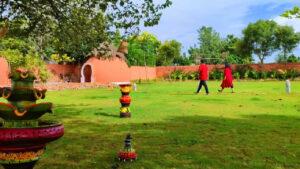Uttarakhand is home to some of the most sacred and stunning places in India, such as Rishikesh, Badrinath, and Kedarnath. These places are not only famous for their scenic beauty, historical significance, and adventurous activities but also for their spiritual value and sacredness. These places are part of the Char Dham Yatra, a tour of four holy sites – Yamunotri, Gangotri, Kedarnath, and Badrinath – nestled high up in the Himalayas.
Rishikesh
Rishikesh is a city in Uttarakhand that is known for its natural beauty, cultural diversity, and spiritual significance. It is often referred to as the “Yoga Capital of the World” because of its many ashrams and yoga centers that offer courses and retreats for spiritual seekers.

Places to visit in Rishikesh Uttarakhand
Laxman Jhula and Ram Jhula: These are two iron suspension bridges that span across the Ganga River and connect the two banks of Rishikesh. They offer a scenic view of the river and the surrounding hills. They are also important pilgrimage spots, as they are associated with the legends of Lord Rama and his brother Laxman.
You May Read
The Beatles Ashram: This is the former ashram of Maharishi Mahesh Yogi, where the famous rock band The Beatles stayed and learned transcendental meditation in 1968. The ashram is now abandoned, but you can still see the graffiti-covered walls, meditation cells, and lecture halls that bear witness to the history and culture of that era.
Neelkanth Mahadev Temple: This is a Hindu temple dedicated to Lord Shiva, who is believed to have consumed the poison that emerged from the churning of the ocean at this place. The temple is located at a height of 1330 meters above sea level and offers a panoramic view of the mountains and valleys.
Neer Garh Waterfall: This is a natural waterfall that cascades down from a height of about 25 meters. It is a refreshing and relaxing spot, where you can enjoy the sound of water and the beauty of nature.
Geeta Bhawan: This is an ashram (a spiritual retreat) that was founded by Swami Shri Purushottam Ji Maharaj in 1950. It is located on the banks of the Ganga River, near Laxman Jhula. It is a place where you can listen to discourses on Hindu scriptures such as Bhagavad Gita, Ramayana, and Upanishads. You can also participate in bhajans (devotional songs), meditation, and yoga sessions.
Also Read:
Places to Visit in Rishikesh – Best Time to Visit, Best Ashrams and Yoga Centers!
Badrinath
Badrinath is a sacred town and a pilgrimage site in Uttarakhand, India. It is one of the four sites in the Char Dham Yatra, a tour of four holy places in the Himalayas. Badrinath is also part of the Chota Char Dham Yatra, a smaller circuit of four shrines in Uttarakhand. Badrinath gets its name from the Badrinath Temple, which is dedicated to Lord Vishnu, the preserver of the universe.

The Badrinath Temple is located on the right bank of the Alaknanda River, at an elevation of about 3,100 meters above sea level. The temple is believed to have been established by Adi Shankara, a Hindu philosopher and reformer, in the 8th century CE.
The temple has a black stone idol of Lord Vishnu, known as Badrinarayan, which is worshipped as the main deity. The temple also has idols of other gods and goddesses, such as Lakshmi, Narada, Garuda, and Kubera. The temple is adorned with intricate carvings, precious stones, and calligraphy.
The temple is open for six months a year, from April or May to October or November. During the winter season, the idol of Badrinarayan is shifted to Joshimath, a nearby town.
Badrinath is also known for its natural beauty and scenic views of the Himalayan peaks, such as Nanda Devi, Trishul, Kamet, and Mana Parvat.
Attractions and Activities for Tourists and Pilgrims, such as:
Tapt Kund: This is a natural hot spring near the temple entrance, where devotees take a bath before entering the temple. The water of the spring is believed to have medicinal and healing properties.
Brahma Kapal: This is a flat platform on the bank of the Alaknanda River, where rituals for the departed souls are performed. It is said that Lord Brahma himself performed a sacrifice here to absolve his sins.
Neelkanth: This is a snow-covered peak that rises behind the temple. It is also called the ‘Garhwal Queen’ or the ‘Sapphire of Garhwal’. It is considered as a sacred symbol of Lord Shiva, who drank the poison that emerged from the churning of the ocean at this place.
Mana: This is a small village near Badrinath, which is the last Indian village before the Tibetan border. It is inhabited by the Bhotia tribe, who follow a traditional lifestyle and culture. The village has some attractions such as Vyas Gufa (a cave where sage Vyas composed the Mahabharata), Ganesh Gufa (a cave where Lord Ganesh wrote down the Mahabharata), Bheem Pul (a natural bridge made by Bheem to cross the Saraswati River), and Vasudhara Falls (a waterfall with a height of 400 feet).
Valley of Flowers: This is a national park and a UNESCO World Heritage Site that lies about 40 kilometers from Badrinath. It is famous for its alpine meadows that bloom with various flowers during the monsoon season. It is also home to many rare and endangered animals and birds, such as snow leopards, musk deer, red foxes, Himalayan monals, and Himalayan griffons.
Kedarnath
Kedarnath is a town and a pilgrimage site in the state of Uttarakhand, India. It is famous for the Kedarnath Temple, which is dedicated to Lord Shiva, one of the most important deities in Hinduism. The temple is located at an altitude of about 3,580 meters above sea level, near the Chorabari Glacier, which is the source of the Mandakini River. The temple is one of the four sites in the Char Dham Yatra, a tour of four holy places in the Himalayas.
The temple has a black stone idol of Lord Shiva, known as Badrinarayan, which is worshipped as the main deity. The temple also has idols of other gods and goddesses, such as Lakshmi, Narada, Garuda, and Kubera.

Best Time to Visit Kedarnath
The best time to visit Kedarnath is from May to October when the weather is pleasant and the temple is open for darshan (worship). During winter months, the town remains closed due to heavy snowfall, and the idol of Lord Shiva is shifted to Joshimath, a nearby town.
Places to visit near Kedarnath and Badrinath
- Badrinath Temple
- Guptakashi
- Rudraprayag
- Kedarnath Temple
- Vasudhara Falls
- Chopta
- Sonprayag
- Gangotri
- Tungnath Temple
How many days are enough for Kedarnath and Badrinath?
Book Divine Badrinath Kedarnath Yatra for 6 days offers a wonderful chance to visit the two most important Hindu pilgrimage sites – Kedarnath and Badrinath.
Which month is best for Kedarnath trip?
Featuring a cold climate mostly around the year, Kedarnath can best be visited in summer. May to June and September to October.
Is there an oxygen problem in Kedarnath?
The oxygen depletion is measured in atmospheric pressure or percent of less oxygen. At Kedarnath, the atmospheric presence of oxygen is only 40 percent of the required level.
Uttarakhand offers a plethora of breathtaking destinations that showcase the state’s natural beauty, spiritual significance, and cultural heritage. The best places to visit in Uttarakhand, Rishikesh stands out as a vibrant hub of spirituality and adventure, while Badrinath and Kedarnath serve as sacred pilgrimage sites high in the Himalayas. Whether you seek tranquility, adventure, or a spiritual journey, Uttarakhand has something to offer everyone. With its picturesque landscapes, ancient temples, and thrilling activities, this northern Indian state truly deserves a spot on every traveler’s bucket list.







